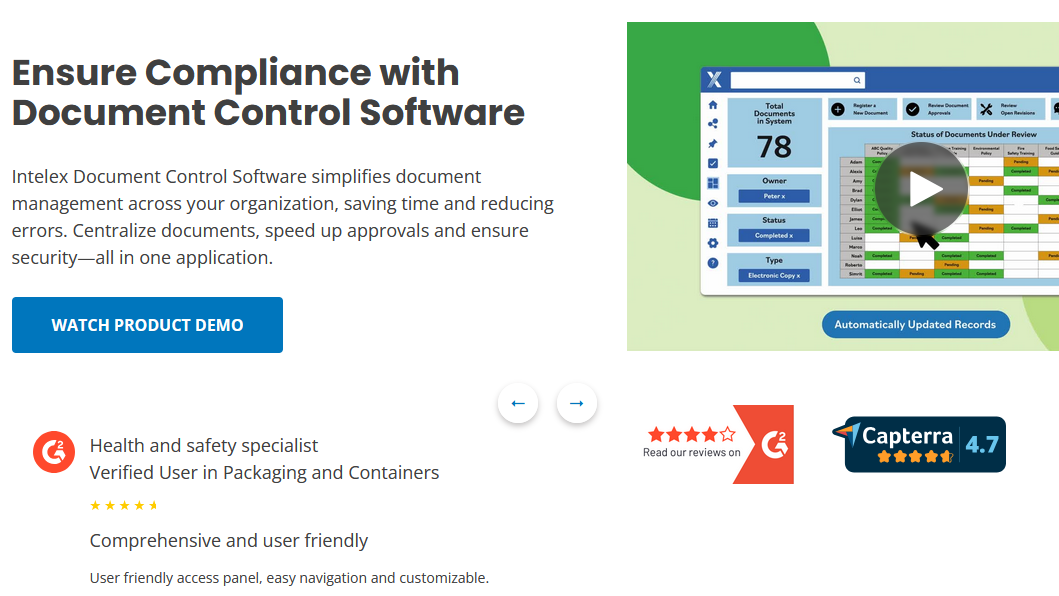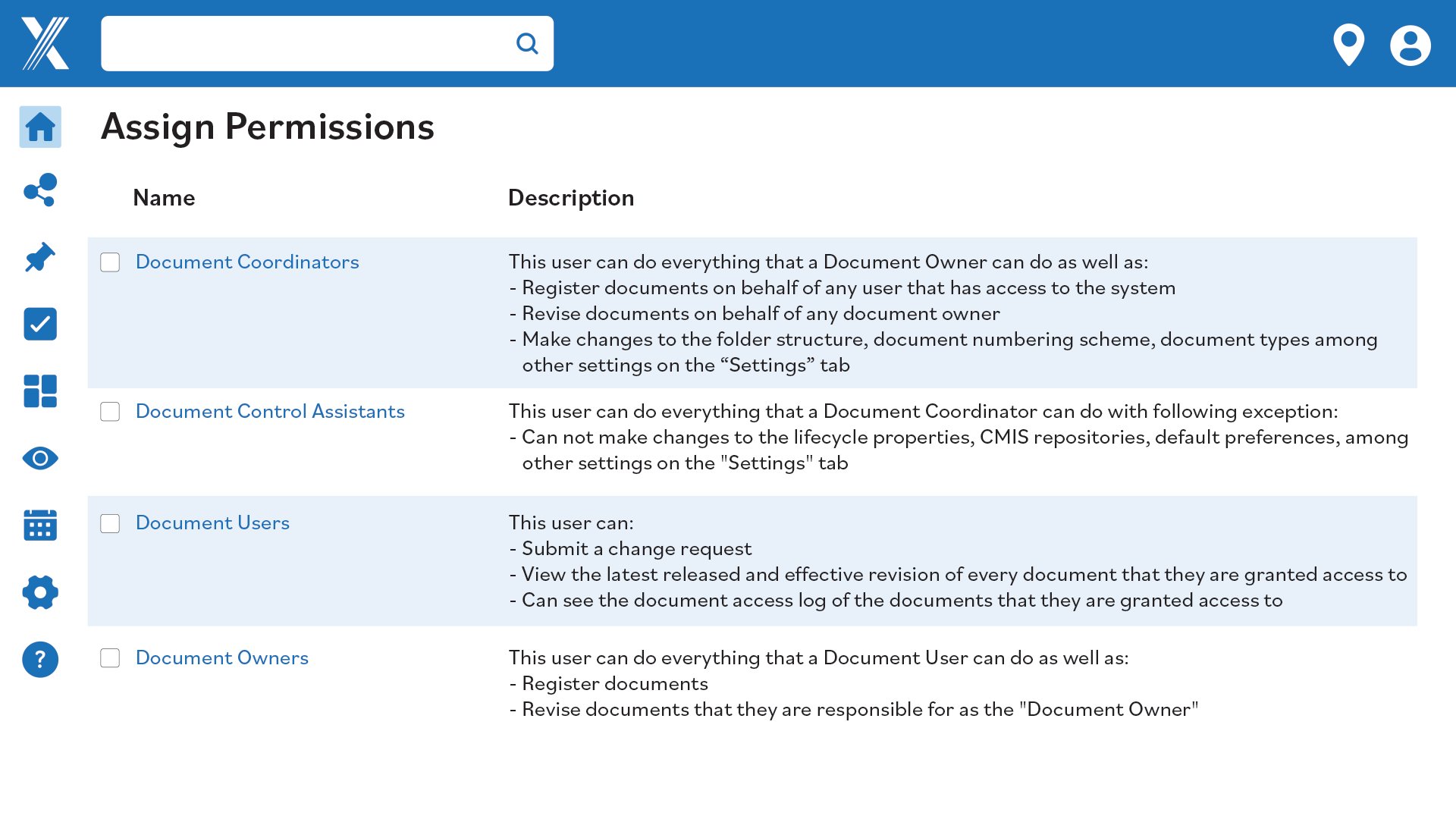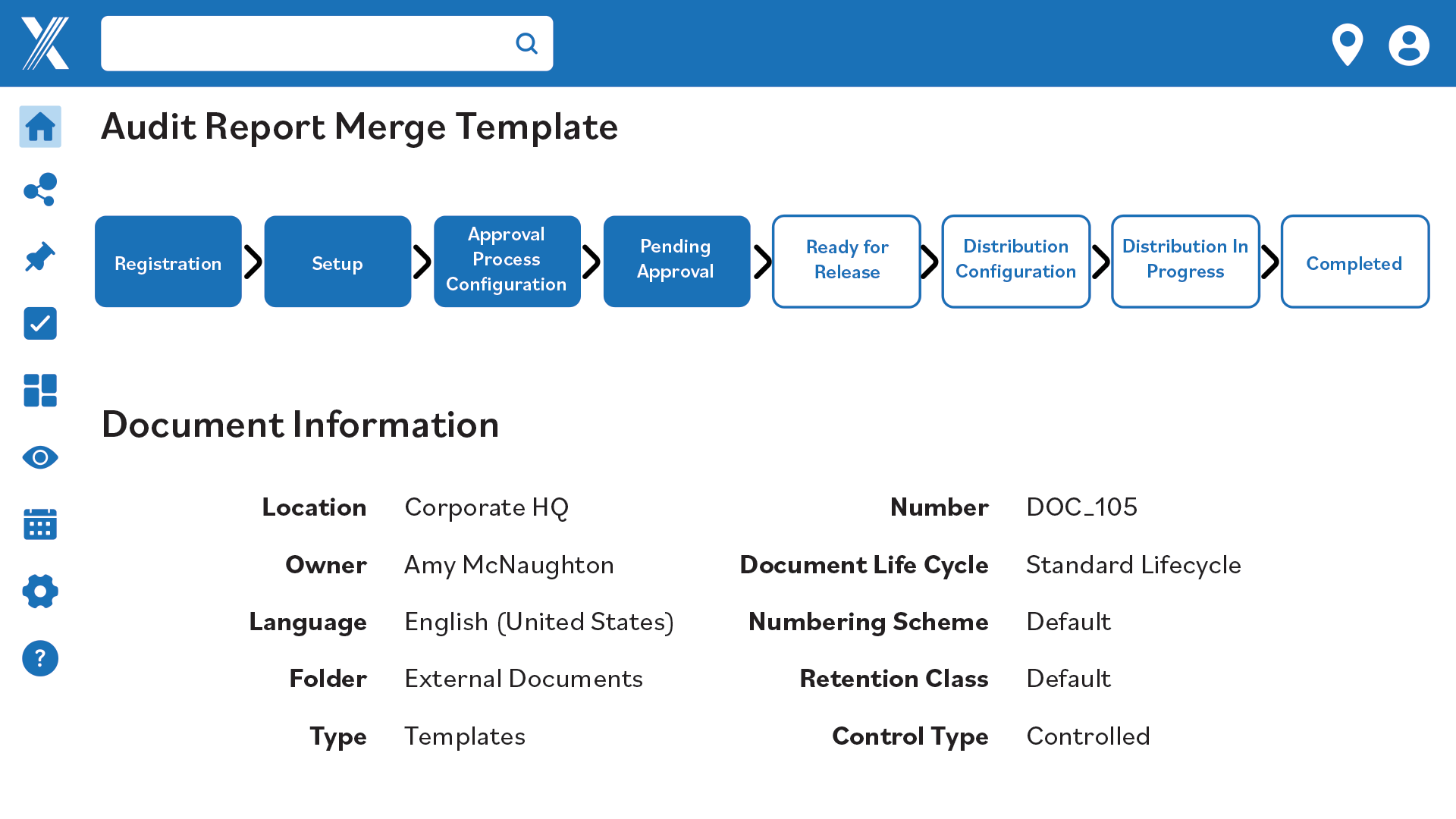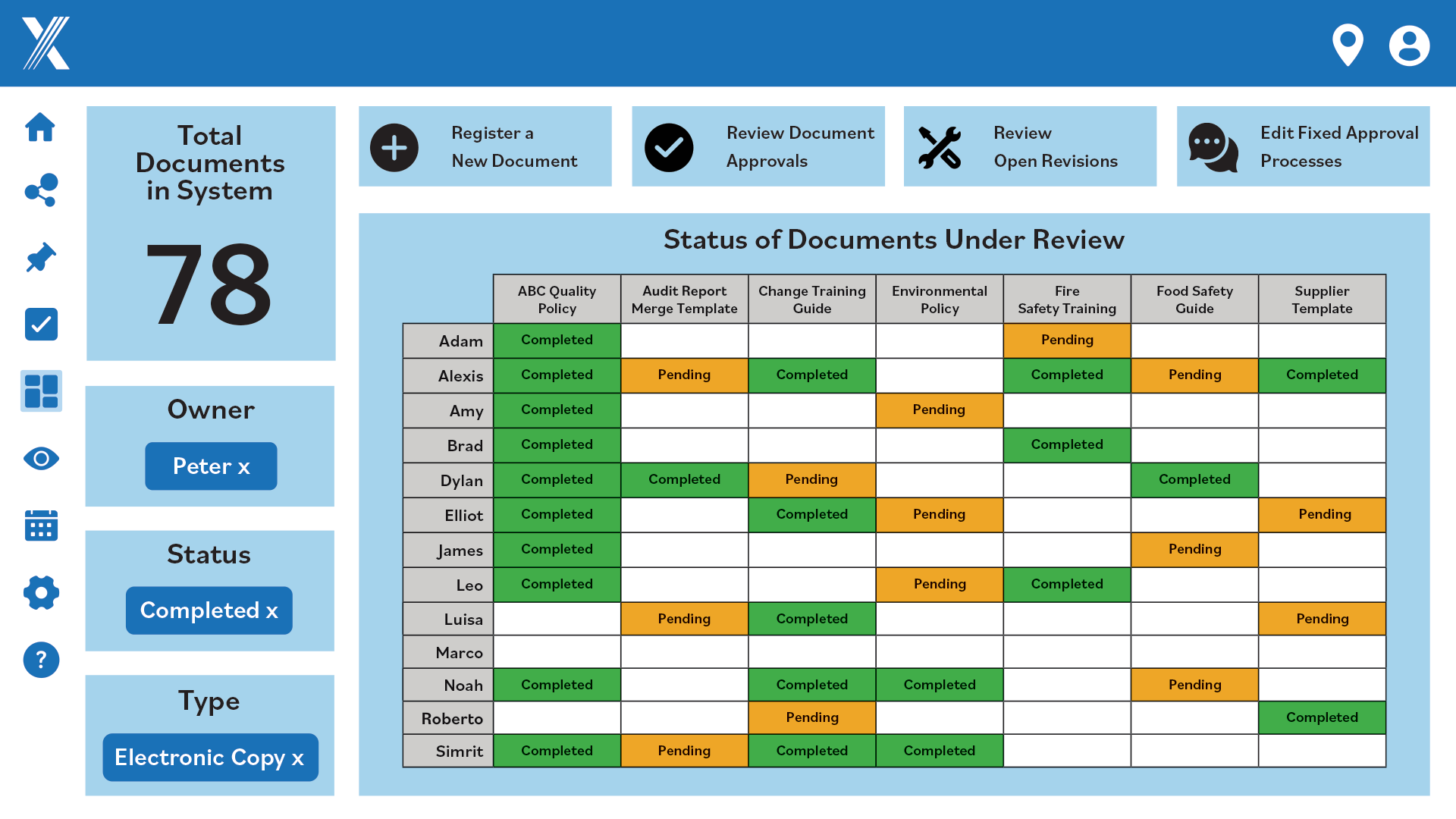Stop Workflow Inefficiencies With Enterprise Document Management Software
January 8, 2025

Every day, your team is losing time, productivity, and peace of mind due to inefficient document management.
- Wasted Hours: Searching for files buried in confusing storage systems eats into valuable time.
- Data Risks: Without proper access controls, sensitive information is exposed, and workflows are disrupted.
- Costly Errors: Outdated or incorrect document versions lead to compliance violations, safety hazards, and costly mistakes.
- Inefficiencies Everywhere: Manual approvals, fragmented reporting, and inconsistent distribution slow progress and frustrate teams.
- Lack of Visibility: Missed deadlines and overlooked tasks go unnoticed due to disorganized tracking.
These challenges don’t just slow your team down—they put your organization at risk.
Table of Contents
- Life cycle tracking
- Flexible folder structures
- Role-based access controls
- Automated document version control
- Speed up approvals and eliminate bottlenecks
- Ensure documents reach the right stakeholders
- Real-time reports and dashboards
- How Johnson Matthey reduced paperwork by 98% with Intelex
- Learn more about Intelex’s enterprise document management software
Every industry needs to manage their important documents
Regulated industries face unique challenges regarding risk management and compliance. They must manage high volumes of critical data, strict reporting requirements and frequently shifting compliance regulations.
For example, basic ISO 9001 certification requires companies to manage more than 25 different types of documents, records and reports on an ongoing basis so they can be audited whenever required.
Imagine searching through endless folders, trying to find the right document among countless versions. When you finally find it, it’s out of date. Now, you have to draft an email to submit a change request and wait for several approvals to receive the right document. This scenario is the reality for many companies managing documents across multiple platforms. It’s also the business case for document management software. Without a centralized, automated tool, the waste of time and resources is staggering.
Take control with enterprise document management software
It doesn’t have to be this way. Intelex’s Document Control software is designed to eliminate the headaches of inefficient document management and give your teams the tools they need to succeed. We’ve even helped companies reduce paperwork by 98%.
Looking for enterprise document management software that will simplify workflows, speed up reviews and approvals, and make finding documents quick and easy? Let’s chat! Book some time to see how Document Control Software can reduce your document management paperwork by 98%.

With Document Control, you can:
- Centralize Documents: Say goodbye to scattered storage locations and ensure your team always knows where to find the latest version.
- Automate Workflows: Save time and reduce manual effort by streamlining reviews, approvals, and task assignments.
- Enhance Visibility: Gain real-time insights into document statuses, overdue tasks, and change requests for better transparency.
- Ensure Accuracy: Maintain complete version control to prevent outdated or incorrect documents from causing disruptions.
- Improve Security: Protect sensitive information with role-based access controls tailored to your organization’s needs.
Manage document workflows seamlessly with life cycle tracking
Inefficient workflows waste time and drain resources, but Intelex’s Life Cycle Management feature puts you back in control. By standardizing the entire document journey—from creation to final distribution—you’ll save hours of effort and reduce compliance risks.
With fully configurable settings, you can:
- Automatically assign approval workflows and review schedules to every document.
- Apply watermarks and expiration dates to ensure sensitive information is protected and always up-to-date.
- Track where each document is in its lifecycle, so you’re never in the dark about its status.
For example, instead of manually chasing approvals or worrying about outdated documents being shared, you can rely on automated reminders and pre-configured review frequencies to keep everything on track.
This structured approach doesn’t just simplify document management—it transforms it. Teams gain back the time spent searching for files or managing chaotic workflows, allowing them to focus on high-impact tasks.
Organize and access documents with flexible folder structures
Inefficient document storage creates chaos, wastes time, and frustrates teams. Intelex’s Flexible Folder Structures solve this by letting you organize files in a way that works best for your organization—making it faster and easier for your team to find what they need, when they need it.
With this system, you can:
- Create folder structures tailored to your operations, such as folders for SOPs, Policies, or Reports.
- Tag documents with relevant attributes (e.g., department, type, or date) to make searching effortless.
- Adjust folders as organizational needs evolve, ensuring your system remains relevant and effective.
For example, an engineer needing a specific SOP can navigate directly to the “Engineering” folder or search for it using predefined tags like “Standard Operating Procedure.” This eliminates wasted time digging through disorganized files or asking colleagues for help.
By making documents easy to locate and store, Intelex reduces the confusion and delays caused by inefficient systems, enabling faster workflows, better collaboration, and less time spent on administrative tasks.
Protect sensitive information with role-based access controls
Data breaches and unauthorized access to sensitive documents can jeopardize your organization’s security, compliance, and reputation. Intelex’s Role-Based Access Controls address these risks by giving you the power to control who can view, edit, or approve documents.

With this feature, you can:
- Assign specific roles, such as Document User (view and suggest changes) or Document Owner (create, revise, and approve).
- Customize permissions based on an employee’s responsibilities or department to ensure users only access what they need.
- Automatically apply watermarks like “Confidential” when documents are printed or shared, adding an extra layer of security.
For example, if a compliance officer needs to review a document, they can view it without being able to edit or delete it, while a document owner retains full control over revisions and approvals. This prevents accidental changes and limits unauthorized access to sensitive information.
By implementing these controls, Intelex reduces the risk of both accidental errors and intentional breaches. It also ensures compliance with internal and external security requirements while streamlining workflows for greater efficiency and peace of mind.
Watch our application spotlight to learn how Document Control can help your business eliminate wasted time, disorganized document storage, unclear versioning, stagnant approvals, compliance risk, and general process and procedural chaos.
Ensure accuracy with automated document version control
Using outdated or incorrect documents can lead to costly errors, compliance failures, and even workplace incidents. Document Version Control Software eliminates these risks by ensuring everyone has access to the most up-to-date, approved documents.
With this feature, you can:
- Automatically set review frequency dates and receive notifications when documents need updating, so nothing slips through the cracks.
- Request changes with assigned due dates, ensuring timely updates and proper lifecycle management.
- Mark older versions as obsolete to prevent accidental use and confusion.
- Link the most recent revision number to related workflows, like audits, training programs, or non-conformance reporting, so every process relies on accurate, current data.
For example, imagine a safety manager preparing for an audit. Instead of scrambling to confirm document accuracy, they can use Intelex’s Document Explorer to instantly locate the latest revision and verify compliance. This seamless integration reduces stress, enhances productivity, and ensures no one is working with outdated or conflicting information.
By centralizing and automating version control, Intelex safeguards your operations against errors, ensures compliance, and streamlines workflows—helping your organization operate more efficiently and safely.
Speed up approvals and eliminate bottlenecks with automated workflow processes
Approval delays caused by endless emails, task tracking across systems, and chasing down approvers can grind productivity to a halt. Intelex streamlines these processes with Automated Workflow Processes that eliminate inefficiencies and speed up approvals.

With Intelex, you can customize approval workflows to fit your document’s needs:
- Parallel Approval: Quickly secure sign-offs by allowing multiple approvers to review the document simultaneously—ideal for straightforward documents like meeting agendas or routine reports.
- Sequential Approval: Ensure rigorous review by routing documents step-by-step, where each approver can either sign off or stop the process. This is perfect for high-stakes documents like compliance manuals or regulatory filings.
- Hybrid Approval: Combine both methods for complex approvals that need multi-department input, such as legal and executive review of contracts or new policy rollouts.
Here’s how it works: Assign approvers, and the system sends automated email notifications with direct links to the document. Approvers can review, approve, reject, or provide feedback all within the platform—no need for manual follow-ups or hunting down misplaced emails.
Imagine submitting a critical compliance document for approval. Instead of sending out reminders and waiting weeks for feedback, your compliance team can assign a hybrid approval process. Legal reviews the document first (sequential), then the HR and Operations teams review it in parallel. Each team member gets automatic reminders, ensuring the document is reviewed and finalized in days, not weeks.
By automating the approval process, Intelex enhances collaboration, reduces administrative burden, and ensures accountability at every step. Say goodbye to bottlenecks and hello to faster, more efficient approvals that keep your projects moving forward.
Reach the right stakeholders with effective distribution
Even the most well-crafted documents lose their value if they don’t reach the right people. Poor distribution often results in employees missing critical updates and organizations struggling to confirm who has reviewed essential documents. Intelex solves this challenge with Effortless Document Distribution, ensuring every stakeholder receives and acknowledges the documents they need.
With Intelex, you can distribute approved documents through multiple methods tailored to your organization’s needs:
- Send a URL: Share a secure link to the document, allowing stakeholders to access it online anytime.
- Electronic Copy: Email a digital version directly to recipients, perfect for teams working remotely or across multiple locations.
- Printed Copy: Generate physical copies for on-site teams, such as factory floor workers or field personnel.
- Repository Integration: Upload documents to a CMIS-compliant repository, ensuring they are centrally stored and easily accessible.
Request Acknowledgement takes document distribution a step further by adding accountability. When a document is sent, the recipient must confirm they have received, reviewed, and accepted it, with the system automatically tracking acknowledgments.
Let’s say a safety manager sends out an updated SOP for handling hazardous materials. Using Intelex, they email the document to all frontline workers and request acknowledgment. Each worker receives a notification, reviews the document, and clicks “Acknowledge.” The safety manager can then view a real-time report of who has and hasn’t acknowledged the document, ensuring no one is overlooked and compliance requirements are met.
By automating and tracking document distribution, Intelex ensures critical updates are delivered to the right people, reducing communication gaps and ensuring everyone is on the same page. Say goodbye to the frustration of missed documents and hello to a streamlined, accountable distribution process.
Gain control and drive improvement with real-time reports and dashboards
Tracking changes, approvals, and acknowledgments with homegrown systems is a mess. You’re chasing down updates in emails, spreadsheets, and meetings—never really knowing where things stand.
Intelex fixes that by giving you Real-Time Reports and Dashboards that show you exactly what’s happening with your documents, now.
- Want to know how many open change requests there are? Or do you want to track acknowledgements for documents?
These reports are fast to set up and run as often as you need.

The real power lies in Customizable Dashboards.
You can take any of the reports you run and create dashboards with effective data visualization. Share it across teams and with stakeholders or use it to quickly create talking points for upcoming reviews.
For instance, a safety manager notices an unusually high number of overdue safety documents on the dashboard. They quickly drill in to see which department is falling behind. Within minutes, they send reminders to the relevant teams, eliminating unnecessary delays.
Intelex turns reactive, scattered tracking into proactive, actionable data. Instead of wasting time on manual follow-ups and incomplete information, you get the clarity needed to make quick decisions, reduce risks, and keep things moving smoothly.
Looking for enterprise document management software that will simplify workflows, speed up reviews and approvals, and make finding documents quick and easy? Let’s chat! Book some time to see how Document Control Software can reduce your document management paperwork by 98%.
How Johnson Matthey reduced paperwork by 98% with Intelex
The Challenge
Johnson Matthey, a multinational specialty chemicals and sustainable technologies company, struggled with inefficient, paper-based document management. With multiple plants and complex workflows, document approvals were slow, prone to errors, and not centralized. To achieve TS 16949 certification, they needed a reliable, automated system for document control.
The Solution
Intelex provided a tailored solution focused on automating document workflows, improving version control, and enhancing user permissions. The company eliminated paper trails, streamlined document approvals, and ensured only the latest versions were in use across all locations.
The Results
- Achieved TS 16949 certification quickly, thanks to faster and more reliable document approvals.
- Reduced paperwork by 98%, freeing up employees to focus on higher-value tasks.
- Centralized document control, ensuring real-time access to approved documents across all plants, ensuring consistency and compliance.
Intelex’s system transformed document control, saving time, improving compliance, and accelerating certification.
Learn more about Intelex’s enterprise document management software
Do you want to simplify workflows, speed up reviews and approvals, and make and sharing documents quick and easy?
We’ve helped companies like Johnson Matthey eliminate 98% of their paperwork with our document control application.
Book time with our team to explore how Intelex can improve your document management workflows!






